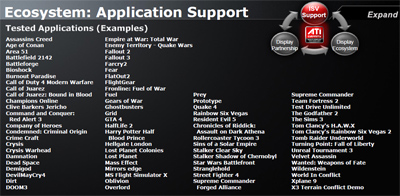What is ATI Eyefinity?
With the introduction of its Radeon HD 5000-series products, AMD unveiled a number of new features - including support for new technologies such as DirectX 11 and ATI Eyefinity.
The latter, announced amid plenty of hype back in September, essentially allows a single graphics card to power up to six displays, up to a maximum theoretical resolution of 8,192x8,192 - though, even with six 30in displays, you're only going to hit 7,680x3,200. Mind-boggling resolutions for those willing to conjure up such a setup.
The lure of the mighty-high res is immense, but let's not get ahead of ourselves. Multi-monitor configurations have been available for some time, and those willing and able have been able to splash out on such setups for years. Trouble is, users wanting to power multiple displays have previously required multiple graphics cards - ATI Eyefinity, on the other hand, promises to do it with just one.
Making it all possible is DisplayPort, with AMD attaching multiple DisplayPort pipelines to a GPU's single display engine. Although the technology can officially drive six displays, the vast majority of AMD's Radeon HD 5000-series graphics cards will ship with support for up to three outputs. Support for six-way output will be reserved for specialist cards only, it seems.
Those who've worked with multi-monitor configurations will appreciate just how useful the additional desktop real estate can be. What's interesting here, however, is that although a triple-monitor configuration is brilliant for productivity - with each independent display standing alone - ATI Eyefinity allows for all three displays to appear as one giant screen.
Using the ATI Catalyst Control Center, users can enable SLS (Single Layer Surface) mode and trick Windows into believing multiple displays are in fact one single screen with a mammoth resolution. Here's Windows 7 (Vista and Linux are also supported) seeing our trio of 23in NEC monitors as a single 5,760x1,080 screen:
In productivity terms, SLS mode isn't quite as useful as it seems - maximising windows will cause them to span all three displays, for example - but when gaming, SLS mode makes implicit sense, providing you're running a supported game.
AMD's graphics card partner, Sapphire - who generously provided our multi-monitor setup - tells us that 21 titles support both SLS and internal CrossFire (ala Radeon HD 5970). The list includes: Anno 1404 (aka Dawn of Discovery), Batman: Arkham Asylum, BattleForge, Call of Duty 4: Modern Warfare, Call of Duty 5: World at War, Call of Juarez: Bound in Blood, Crysis, Crysis Warhead, Dawn of War 2 (Warhammer 40K), Elder Scrolls IV: Oblivion, Enemy Territory: Quake Wars, Fallout 3, Far Cry 2, GhostBusters, Left 4 Dead, Need for Speed: Shift, Race Driver: GRID, STALKER Clear Sky, Tom Clancy's HAWX, Unreal Tournament 3 and World of Warcraft (plus expansions).
The number of SLS-supporting games is far greater, as envisaged by the AMD-provided slide below, but readers should be aware that not all of following titles are CrossFire Eyefinity-enabled, and therefore won't harness the full power of both 5970 GPUs.
Why would you want to game across multiple monitors? Bragging rights is one of the first reasons that'll spring to mind, but there's more to it than it, and you'll find that such a configuration can actually offer a far more immersive gaming environment thanks to a wide field of view that'll provide excellent "surround-sight" visuals, as AMD likes to call it.
There are, of course, a few provisos. That massive field of view - which, we repeat, is excellent - will be hindered by the bezels of each independent display. Whilst gaming, it can initially be a jarring experience, as you watch content skip an inch or two as it travels from display to display. Not a deal breaker by any means, but we are looking forward to the arrival of displays equipped with ultra-thin bezels - Samsung is one manufacturer who has such displays gearing up for production.
Question is, can AMD's latest high-end GPUs deliver acceptable frame rates whilst pushing a trio of displays and a total resolution of 5,760x1,080?













